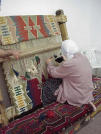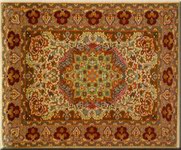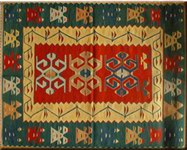|
 Inrecent years there has been a rapidly increasing interest
in carpets. Many books, catalogues, introductory texts and more specialised
works have appeared, and yet despite all the research put into these publications,
the subject of carpets still bewilders and confuses some people. Despite
this carpets are still highly sought after, with their rich warm tones,
and extraordinary patterns and motifs. Each hand made carpet is a totally
individual work of art representing a level of craftsmanship seldom surpassed. Inrecent years there has been a rapidly increasing interest
in carpets. Many books, catalogues, introductory texts and more specialised
works have appeared, and yet despite all the research put into these publications,
the subject of carpets still bewilders and confuses some people. Despite
this carpets are still highly sought after, with their rich warm tones,
and extraordinary patterns and motifs. Each hand made carpet is a totally
individual work of art representing a level of craftsmanship seldom surpassed.
In this brief introduction we hope to give you a greater insight into
the history, traditions and wonderful uniqueness of artistry, that ensures
the continued demand for high quality hand made carpets throught out the
world.
HISTORY
The oldest completed knotted carpet, dated to 5th century BC, was found
in the frozen tomb of a nomadic chieftan at Pazyrk in the Altai Mountains.
It is believed that the art and craft of the knotted pile carpet began,
then developed and flourished to a high technical and artistic level amidst
the pastoral noma ds in the steppes of central Asia. The knotted carpet
then reached the middle east in the 8th or 9th centuries with the nomadic
Turkish tribes who began migrating into the region at that time. Very
little is then known about the history of the carpet until the 12th, 13th
and 14th centuries when examples from the Turkish Selcuk Period were found
in various Turkish mosques. these Selcuk examples are today on display
in the Turkish and Islamic Arts museum. ds in the steppes of central Asia. The knotted carpet
then reached the middle east in the 8th or 9th centuries with the nomadic
Turkish tribes who began migrating into the region at that time. Very
little is then known about the history of the carpet until the 12th, 13th
and 14th centuries when examples from the Turkish Selcuk Period were found
in various Turkish mosques. these Selcuk examples are today on display
in the Turkish and Islamic Arts museum.
Often depicted in european paintings in the 16th century, carpets were
used by the artist to indicate the high economic and social status of
the subject. Modern Carpet History really began in the 19th century, when large cottage
industry and workshop productions flourished to meet the ever increasing
demand for handmade carpets on the international markets.
THE CRAFT OF CARPETS
For as long as anyone can remember, women in various parts of Asia have
been learning the skills of carpet weaving from an extremely young age.
Many of the carpets woven were designed directly from m emory using traditional
materials, colors and motifs, characteristic of the region. Every carpet
was unique and used a symphony of ancestral and sometimes sacred patterns
that reflected the fabric of local life and the identity of weaver. emory using traditional
materials, colors and motifs, characteristic of the region. Every carpet
was unique and used a symphony of ancestral and sometimes sacred patterns
that reflected the fabric of local life and the identity of weaver.
Carpets are always handmade, usually of wool or sometimes cotton and only
occasionally with the more expensive additon of silk. Highly skilled weavers
were usually also proficient in sorting, combing, spinning and plying
the lustrous wools.
The use of tradional natural dyes was a hereditary skill and many women
would pool their resources and expertise to ensure a lasting and radiant
range of dye colors. Although synthetic dyes are used more prolifically
in modern times, the tonal
variances and hues of natural dyes give so many carpets their high intrinsic
value.
 The handweaving of double or single knotted carpets that often comprised
a young woman's dowry, took months or even years of skill. Carpets were
not only used traditionally as floor coverings but used on ceremonial
occasions, as tent screens, wall hangings, cradle and sofa covers and
also as prayer rugs. The young women's dreams and inspirations were often
intermixed with a wealth of ancestral designs and symbols to create carpets
that would represent a desire for fertility, protection, prosperity, etc.
The age old tradition of carpet making survives today despite dramatically
changing lifestyles local customs have beenmodif The handweaving of double or single knotted carpets that often comprised
a young woman's dowry, took months or even years of skill. Carpets were
not only used traditionally as floor coverings but used on ceremonial
occasions, as tent screens, wall hangings, cradle and sofa covers and
also as prayer rugs. The young women's dreams and inspirations were often
intermixed with a wealth of ancestral designs and symbols to create carpets
that would represent a desire for fertility, protection, prosperity, etc.
The age old tradition of carpet making survives today despite dramatically
changing lifestyles local customs have beenmodif ied to include the use
of sophisticated patterns and modern technology but the skill of the experienced
artists and their individual interpretation of motifs and colors ensures
the highest quality is still maintained in the carpets of today. ied to include the use
of sophisticated patterns and modern technology but the skill of the experienced
artists and their individual interpretation of motifs and colors ensures
the highest quality is still maintained in the carpets of today.
A high quality, carefully selected handmade carpet is not only a decorative
item but increases in value and beauty as it is used; its integrity and
traditions passed from generation to generation.
Our carpets at Indigo Gallery are meticulously chosen to reflect the finest
creative skill and technical quality of some of Asia's greatest unknown
women artists.
|